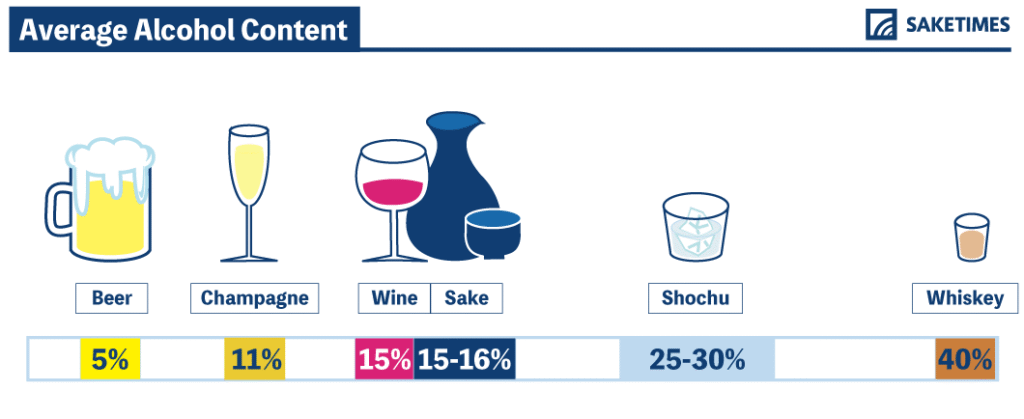
Sake, Japan’s beloved rice wine, is known for its unique flavor and cultural significance. However, like any alcoholic beverage, understanding how much sake it takes to get drunk is crucial for responsible enjoyment. This article delves into the factors influencing intoxication levels from sake, providing insights into moderate consumption guidelines and potential health risks associated with excessive drinking.
By exploring the alcohol content of sake, individual variations in metabolism and tolerance, and recommended serving sizes, you’ll gain a comprehensive understanding of how to savor sake responsibly while minimizing potential negative effects.
Sake Alcohol Content (ABV)
Sake, brewed from fermented rice, typically boasts an alcohol by volume (ABV) ranging from 14% to 18%. This ABV can vary depending on the brewing process, type of rice used, and desired flavor profile. Higher-ABV sake varieties, often labeled as “Junmai Daiginjo” or “Ginjo,” tend to be smoother and more complex in taste but pack a stronger punch. Conversely, lower-ABV sake, like “Honjozo,” might have a lighter flavor but still contribute to intoxication.
Understanding the ABV of your chosen sake is essential for estimating how much you’re consuming. Always check the label for accurate information and remember that even seemingly mild sake can accumulate in your system over time.
Factors Affecting Intoxication
The amount of sake required to reach a state of intoxication varies significantly from person to person due to several factors:
Body Weight and Metabolism
Individuals with higher body weight generally require more alcohol to feel the effects compared to those with lower body weight. Metabolism, the rate at which your body processes alcohol, also plays a crucial role. Faster metabolisms can break down alcohol quicker, leading to a slower onset of intoxication.
Tolerance Level
Regular alcohol consumption can lead to increased tolerance, meaning you might require more sake to achieve the same level of intoxication as someone with lower tolerance. However, it’s important to note that tolerance doesn’t mean immunity to negative effects; excessive drinking can still pose health risks regardless of your tolerance level.
Food Consumption
Eating before or while consuming sake can slow down alcohol absorption into the bloodstream, delaying the onset and intensity of intoxication. Fatty foods in particular can help delay the process due to their slower digestion rate.
Moderate Sake Consumption Guidelines
Moderation is key when enjoying any alcoholic beverage, including sake. General guidelines suggest that for a standard 750ml bottle of sake (around 14-18% ABV), moderate consumption equates to 2-3 servings.
One serving is typically considered to be approximately 1.5 ounces. However, individual tolerance and factors mentioned previously can influence these guidelines. It’s always best to err on the side of caution and pace yourself throughout the evening.
Health Risks of Excessive Sake Drinking
While moderate sake consumption may not pose significant health risks for most individuals, excessive drinking can lead to various negative consequences:
Liver Damage
The liver is responsible for processing alcohol, and prolonged heavy drinking can overload this organ, leading to fatty liver disease, cirrhosis, and even liver failure.
Cardiovascular Problems
Excessive sake consumption can increase blood pressure, raise cholesterol levels, and contribute to the development of heart disease and stroke.
Mental Health Issues
Alcohol abuse can exacerbate existing mental health conditions like anxiety and depression or trigger new ones. It can also impair judgment, leading to risky behaviors and social problems.
Responsible Sake Consumption
Enjoying sake responsibly involves being mindful of your limits, pacing yourself, and staying hydrated throughout the evening. Here are some tips for responsible sake consumption:
Know Your Limits
Pay attention to how your body reacts to alcohol and stop drinking when you feel its effects. Don’t try to keep up with others or feel pressured to drink more than you’re comfortable with.
Pace Yourself
Sip your sake slowly and savor the flavor rather than gulping it down quickly. Alternate alcoholic beverages with water or non-alcoholic drinks to stay hydrated and slow down alcohol absorption.
Conclusion
Understanding how much sake it takes to get drunk is essential for enjoying this traditional Japanese beverage responsibly. While individual factors influence intoxication levels, moderate consumption guidelines and awareness of potential health risks can help you savor sake safely and minimize negative consequences. Remember to always drink responsibly, pace yourself, and stay hydrated for a pleasurable and enjoyable experience.
